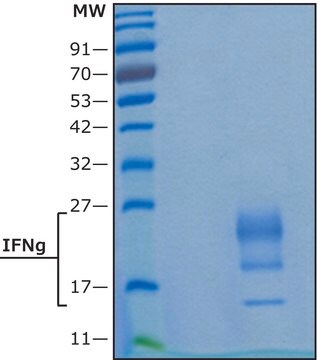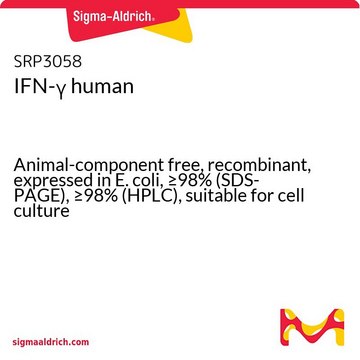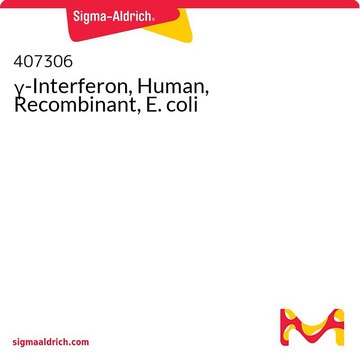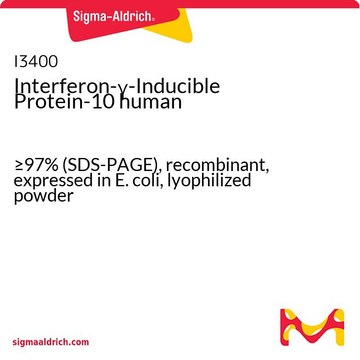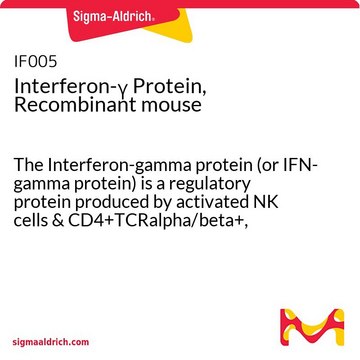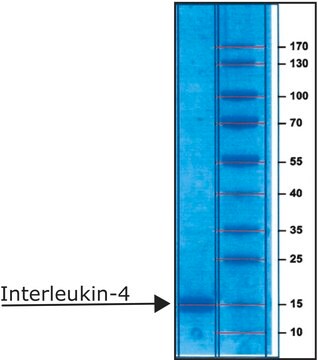Wszystkie zdjęcia(1)
Kluczowe dokumenty
I3265
Interferon-γ human
recombinant, expressed in E. coli, ≥98% (SDS-PAGE), lyophilized powder, suitable for cell culture
Synonim(y):
IFN-γ
Zaloguj sięWyświetlanie cen organizacyjnych i kontraktowych
About This Item
Polecane produkty
pochodzenie biologiczne
human
Poziom jakości
rekombinowane
expressed in E. coli
Próba
≥98% (SDS-PAGE)
Formularz
lyophilized powder
masa cząsteczkowa
~17 kDa
opakowanie
pkg of 0.1 mg
metody
cell culture | mammalian: suitable
zanieczyszczenia
≤1 EU/μg endotoxin
kolor
white
rozpuszczalność
water: soluble 1.000 mL, clear, colorless
numer dostępu UniProt
temp. przechowywania
−20°C
informacje o genach
human ... IFNG(3458)
Szukasz podobnych produktów? Odwiedź Przewodnik dotyczący porównywania produktów
Zastosowanie
Interferon-γ human has been used:
- to study the effect of interferon-γ on cultured trophoblasts in absence and presence of fibronectin
- to analyse factors which participate in the production of antibody microarrays on glass support
- for ELISA (enzyme-linked immunosorbent assay) method to understand the effect of interferon-γ in human gingival fibroblasts in presence of bacterial challenge
Działania biochem./fizjol.
IFNG (interferon-γ) is a type-2 interferon which is produced by Th (T helper cells)-1 lymphocytes, CD8 cytotoxic lymphocytes, natural killer (NK) cells, and natural killer T (NKT) cells. It plays an important role in innate and adaptive immune responses, and helps in defense against bacterial infections, dimorphic yeast and some viral infections. High expression of IFNG is common in many autoimmune diseases, such as systemic lupus erythematosis, Sjögren syndrome, inflammatory bowel disease and multiple sclerosis.
Postać fizyczna
Lyophilized from phosphate buffered saline.
Komentarz do analizy
The biological activity is measured by a viral resistance assay.
Ta strona może zawierać tekst przetłumaczony maszynowo.
produkt powiązany
Numer produktu
Opis
Cennik
Kod klasy składowania
11 - Combustible Solids
Klasa zagrożenia wodnego (WGK)
WGK 3
Temperatura zapłonu (°F)
Not applicable
Temperatura zapłonu (°C)
Not applicable
Środki ochrony indywidualnej
Eyeshields, Gloves, type N95 (US)
Wybierz jedną z najnowszych wersji:
Masz już ten produkt?
Dokumenty związane z niedawno zakupionymi produktami zostały zamieszczone w Bibliotece dokumentów.
Klienci oglądali również te produkty
M J Lappin et al.
Archives of oral biology, 61, 36-43 (2015-10-30)
To investigate the potential effects of IFN-03A5 on the responsiveness of human gingival fibroblasts to bacterial challenge. mRNA and protein expression of CD14, TLR2 and TLR4 in human gingival fibroblasts was detected by quantitative polymerase chain reaction (Q-PCR) and flow
K Pfizenmaier et al.
Cancer research, 45(8), 3503-3509 (1985-08-01)
The effect of recombinant gamma-interferon (IFN-gamma) on established human colon carcinoma cell lines as well as fresh tumor cells from colon carcinoma patients has been investigated with respect to growth inhibition, enhancement of HLA expression, and modulation of immunogenicity. A
R Pijnenborg et al.
Molecular human reproduction, 6(7), 635-641 (2000-06-29)
Tumour necrosis factor (TNF)-alpha and interferon (IFN)-gamma, produced by maternal inflammatory cells, may compromise trophoblast survival at the trophoblast-maternal interface and notably in the placental bed which is invaded by trophoblast. Extracellular matrix components, e.g. fibronectin, may enhance trophoblast survival.
Marielle Kaplan et al.
Inflammation, 41(4), 1477-1487 (2018-04-25)
Arterial macrophages comprise a heterogeneous population: pro-inflammatory (M1) and anti-inflammatory (M2). Since C-reactive protein (CRP) is produced by macrophages in atherosclerotic lesions, understanding of CRP regulation in macrophages could be crucial to decipher inflammatory patterns in atherogenesis. We aimed to
Meager, A. et al.
Lymphokines and Interferons, A Practical Approach, 129-129 (1987)
Nasz zespół naukowców ma doświadczenie we wszystkich obszarach badań, w tym w naukach przyrodniczych, materiałoznawstwie, syntezie chemicznej, chromatografii, analityce i wielu innych dziedzinach.
Skontaktuj się z zespołem ds. pomocy technicznej